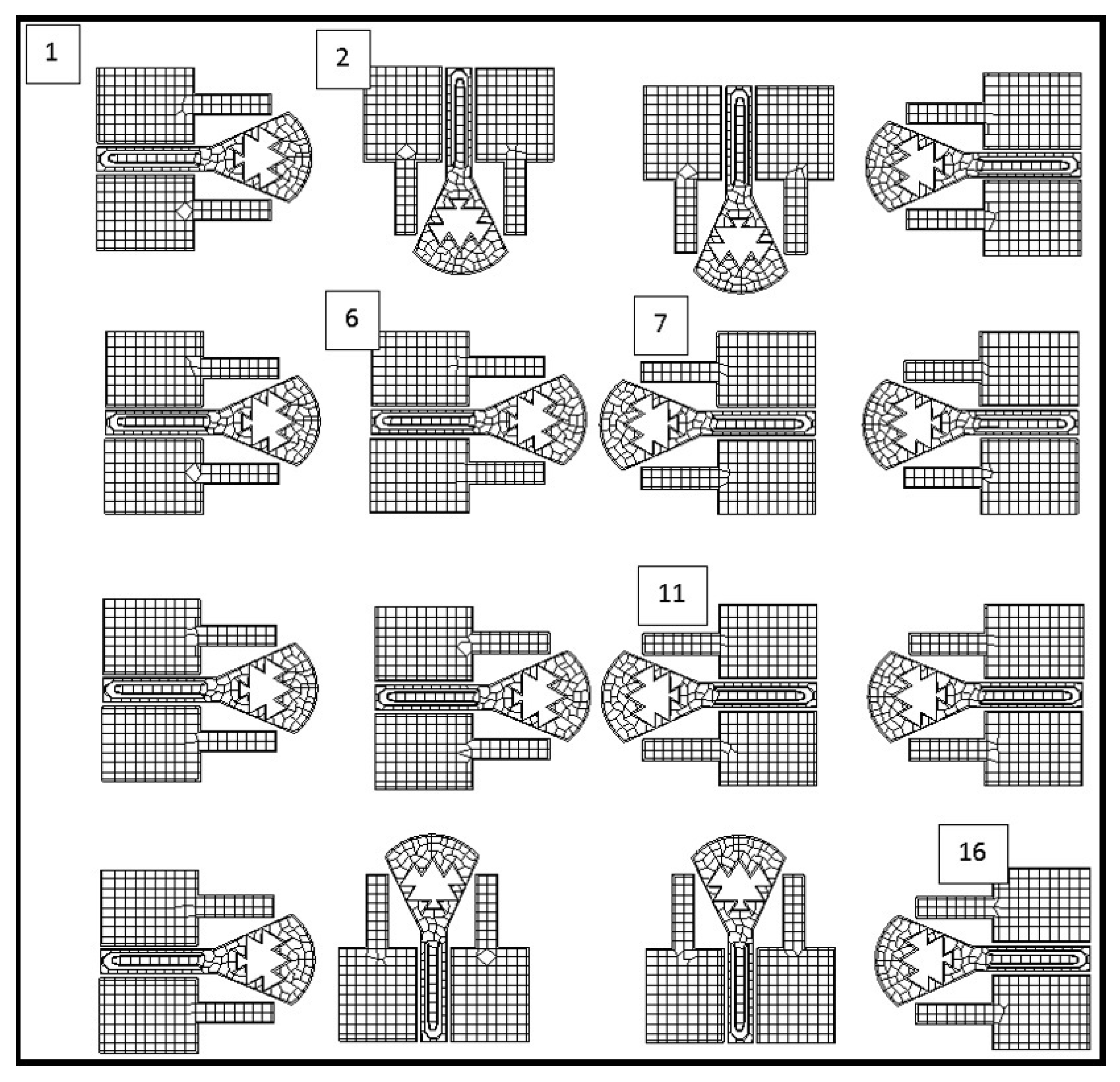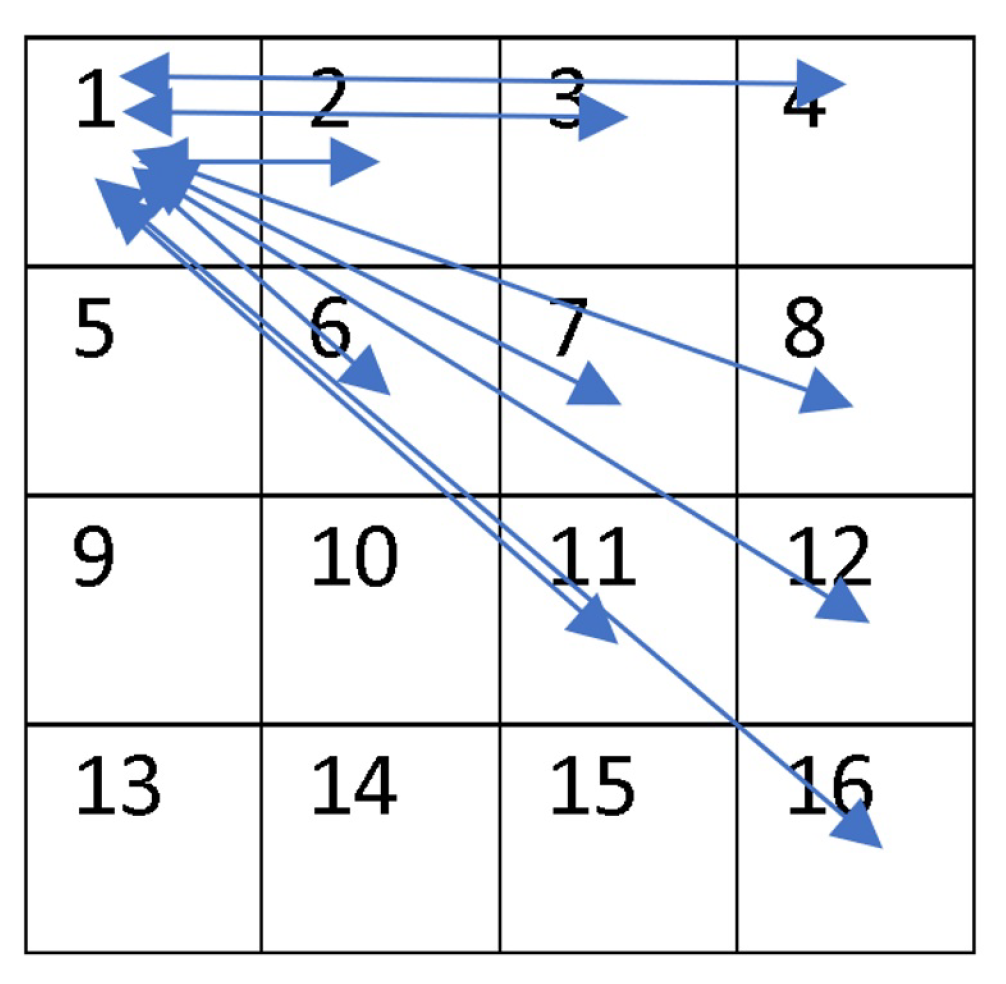1. Introduction
Emerging applications such as bio-telemetry, GPS, and RFIC for wrist-wearable communication applications, wireless clock distribution, IoT/biomedical, wireless power transfer, wirelessly powered dielectric sensors, sensor networks and wireless tagging, wireless network-on-chip (WNoC) systems and chip-to-chip wireless communication systems, have motivated innovations in wireless transceiver systems, components, architectures, and technologies [
1]. In these applications, wireless communication with a wide bandwidth is essential in order to achieve a higher data rate. System-on-chip (SoC) systems based on a multi-processor (MPSoC) architecture with a wide variety of heterogeneous intellectual property (IP) blocks ensure that on-chip communication plays a key role in determining the reliability, performance, area, and power consumption of these devices. Developers of network-on-chip (NoC) architectures have suggested shifting the bus interconnections [
2] to wireless communications, since MPSoC systems require such changes. Wireless NoC present the potential for scalable interconnect architectures with a reduced latency for next-generation NoCs; therefore, the wireless-NoC topology can be totally different from that of a traditional NoCs. Recent research has implemented wireless-NoC (WiNoC)-based antennas [
3,
4] to provide a scalable and flexible on-chip communication infrastructure. On-chip antennas have several advantages, which lead to low signal losses and higher integration levels, as well as improved latency and broadcasting capabilities. In the literature, on-chip antennas operate on a single wireless channel based on the resonant frequency.
The advantage of ultra-wide-band (UWB) antennas is their quasi-omnidirectional characteristics and their good radiation [
5]. Many mictrostrip-fed antenna designs have revealed acceptable behavior when targeting the use of the free licence band from 3.1 to 10.6 GHz, especially when they have circular and elliptical coplanar waveguide (CPW)-fed slots [
6]. Reference [
7] showed how frequency-selective surface (FSS) techniques enhance antenna gain for UWB antennas. This technique was deployed to boost the performance of UWB antennas and to increase the gain by using a circular polarized (CP) antenna. Reference [
8] studied and compared a V-shaped UWB monopole antenna and dual-band UWB notch antenna to the previous literature. They observed less group delay, a linear phase, stable radiation patterns, and dual notch bands, making their system feasible for use in UWB applications.
We were inspired by the existing literature to design a novel Bi-WB on-chip antenna for wireless NoC applications. As the number of on-chip intellectual properties (IPs) continues to increase, wireless communication technology channels are becoming limited [
4], particularly for simultaneous wireless communication. A recent work proposed a multi-channel wireless NoC based on traditional NoC topologies [
9]. Despite challenges owing to the on-chip antenna design, this paper suggests a novel on-chip antenna with wireless bi-wide-band frequencies. Multiple wireless channels are created by splitting the two proposed antenna bands into channels. Each channel is assigned exclusively to the communication between each pair of antennas.
This work is structured as follows.
Section 2 (Wireless-Based NoC Topology) presents the wireless topology. In
Section 3 (Wireless Channel), the channel characteristics and indoor model are provided for no-loss environment conditions. A novel on-chip antenna (NoChA) is presented, characterized and a description of the design steps is provided in
Section 4 (On-Chip Antenna). Then, a brief comparison with some reference antennas is presented.
Section 5 (Assignment of Frequencies) describes the frequency channel assignment process.
Section 6 highlights the principal conclusions and perspectives. Eventually, the study of (
) antenna-dispositions is presented in
Appendix A with three subsections detailing how we chose the best arrangement among all the possible cases investigated.
5. Assignment of Frequencies
In this section, we identify the best antenna layout, providing the best gains
. We consider a wireless based-NoC topology of
on-chip cores, as depicted in
Figure 13. To achieve this optimal layout of the antennas, an algorithm has been proposed. The algorithm scans all possible layouts randomly by calculating the parameters
S. The best parameters indicate the best layout.
After calculating the and the transmission coefficient of on-chip antennas, the assignment of channel frequencies would respect the following constraints:
Rule 1:
(dB) ≤ threshold, for example,
dB, as we do not tolerate the tenth losing power. (giving
and
) and k represents the indexes of the appropriate bands. Frequency bands
are deduced from
Figure 8 as follows:
(m1, m3) and
(m4, m8). Markers’ values are indicated in
Table 1.
Rule 2: (dB) ≥ ( of max() or more than −20 dB (giving and ).
Rule 3: One or more bands are allocated to the , where Rule 1 is respected.
Rule 4: Each Bik is subdivided into one or more channels Chikp, where p represents the indexes of the appropriate channels, referring to Bik.
where
i is the antenna index from 1 to 16,
k is the frequency band index (1,2), and p is the channel index. The frequency assignment process, respecting the above rules, should eliminate frequency interferences. The transmit gain
from antennas
to
is given by Equation (
5):
The studied disposition is shown in
Figure 13 as
IP-antennas (
) in a square grid so 16
are enumerated from 1 to 16. Each
can transmit to
on exclusive channels, chosen as having the optimum (available and highest) transmission gain. In the case that
would transmit data to
, noted by
, we have to respect the above rules (Rule 1 to Rule 4) to deduce the right frequency set band
(channels
) corresponding to the maximization of
. Thus, we obtain a bijection between
and
.
Figure 14a,b illustrates the case of
and
, and
Figure 14a depicts
(acceptance aptitudes of
–
, calculated by means of Equation (
6).
Figure 14b shows the gain
, calculated using Equation (
5). We have represented the gain
from
to
. The acceptance aptitude of
is the inverse of the linear
given by Equation (
6):
In fact, such intersections should be well managed in roder to minimize interferences or coupling phenomena, which degrade on-chip antenna communications. An algorithm was developed to filter bijective spectral bands between
and its assigned spectral channels set. Thus, one chosen frequency cannot be used for two different
distinctly in the case of transmission and receiving signals. Assigning an exclusive set of channel frequencies for each
is actually the intersection of the highest
,
, and
values, where we omit the used channel frequencies of other
. In the
system, we distinguish 240 = 16 × 15 possible cases of
, which involve at least 240 channel frequencies that we have to assign. On-chip IPs communicate simultaneously with each other, thanks to the unique channel assigned per wireless link. In our case, we have two bandwidths, respectively, of 15.06 GHz
and 55.8 GHz
around 70.86 GHz
that can be deployed to 240
, having six sub-channels of 49.2 MHz each (about 50 MHz). To achieve this aim, we subdivide 70,860/(240 × 6) about 70,860/1440 and obtain 49.2 MHz for each sub-channel. To avoid the interference issues, we do not use the tenth of 49.2, around 4.92 MHz, and we assign only six efficient sub-channels, having 44.28 MHz per couple
, of which a tenth is about 4.92 MHz, used as a gap between two consecutive sub-channels, as depicted in
Figure 15, where dark columns indicate frequencies intervals/gaps, which are not used. We identify each sub-channel by the mother band (
or
), a number between 1 and 1440, an interval of operational frequencies having [
,
] limits centered in
and with two gaps (frequencies that are not used)
as seen clearly in
Table 4, then detailed in
Table 5 for the case of
sub-channels. The relation between frequency and sub-channel number (
) is presented in Equation (
7) as follows:
where
is the last sub-channel number of the preceding band,
is the depicted frequency from the gain
sorted in descending order, and
is the starting frequency of the current band number
p. In our case, the antenna provides two bands, so that
p is equal to 1 or 2. In this example,
GHz,
,
, and
GHz; this gives
.
The filling of
Table 4 and the deduction of
Table 5 is accomplished according to an efficient assignment of frequencies, according to Algorithm 1.
Algorithm 1 Frequencies’ assignment algorithm per Aij (Input parmeters: n, m) (here n = 16 and m = 6) (Output: Alloc([1..(n ∗ (n − 1) ∗ m)]) (here Alloc([1..1440]) |
|
Where
U is an integer counter of the sub-channel assignment number in {1, 2, 3, 4, 5, 6};
G is a set of
for each
deduced from Equation (
5);
is a set
sorted in descending order for each
according to
; and Alloc is an array of 1440 (sub-channels) structures composed of (
V:
N:
, where
V indicates if the sub-channel is allocated,
is the number of the transmitting antenna (
), and
is the number of the receiving antenna (
), and
N is order number of assigned sub-channels. The algorithm is optimized by considering Equation (
5). According to this equation, the received power decreases considerably when the inter-antenna distance increases. The set of 240
should be sorted in descending order by the distance
between
and
, as presented in
Figure 16. Actually, the number
m of assigned sub-channels per
(here
) is an important parameter. When it is changed, we modify the sub-channel width
, where
GHz and n is the number of antennas (16 = 4 × 4). However, whenever we execute Algorithm 1 we will obtain a new frequency plan per
. A sample of an assignment plan resulting from the proposed Algorithm 1 is shown in
Figure 17, where each of the 240
antenna couples is assigned six exclusive sub-channels. This can help to hop frequencies and obtain easier
access.
6. Conclusions
In this work, we have presented the design of an innovative millimeter-wave fractal antenna to enable on-chip pure wireless communications. The antenna operates efficiently in two wide bands, ( GHz) and ( GHz). The proposed antenna system-() showed satisfactory communication performance in terms of communication between many sub-channels, size, gain, polarization, and bandwidth. The antenna is practically qualified to be integrated on-chip.
We subdivided and into 1440 sub-channels, with MHz as the width, and only MHz were exploited and the MHz band remained as a gap inter-sub-channel to eliminate the risk of interference between two consecutive sub-channels. We assigned exclusively to each antenna couple m (six) sub-channels, sorted by their gain . Thus, the first sub-channel corresponds to the best quality and the sixth to the lowest quality. Hence, the wireless NoC provides requirements such as reliability, guaranteed bandwidth, and latency.
The proposed wireless NoC can efficiently improve performance. Moreover, the WiNoC should overcome limitations due to the increased likelihood of timing and data-errors, crosstalk, and environmental factors such as electromagnetic interference, which represent issues to confront and challenges to overcome in future works. As a first perspective, frequency hopping via time slot multiple access (//) may be an alternative solution, meaning that one chosen frequency could be used by two different s at different time slots. The second perspective is to assign not only one antenna but two radiators per to ensure full-duplex communication, with the first antenna used transmission and the second one used for receiving.































